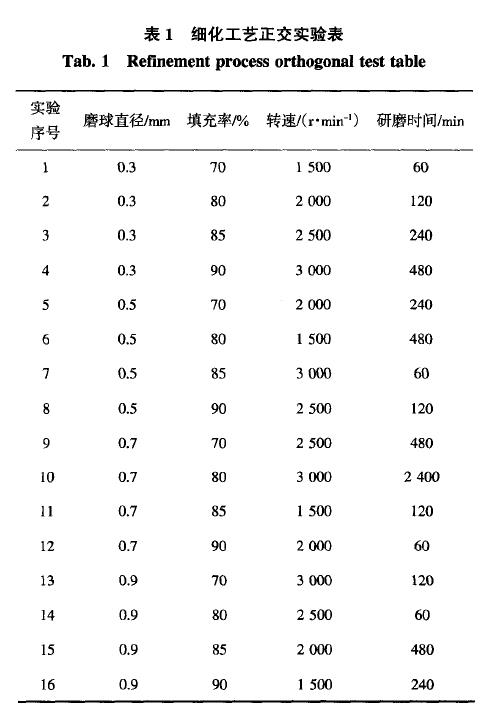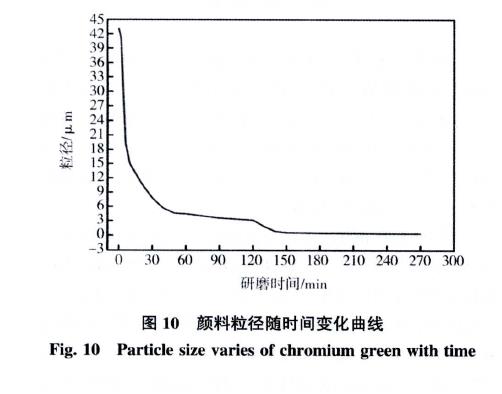Abstract
Chromium green pigment, known for its excellent weather resistance and visible light reflection, finds extensive use in camouflage coatings. Achieving the desired particle size of this pigment is crucial for its spectral properties. This study explores the wet grinding method to prepare micro and nano powders of chromium green pigment efficiently. It applies grinding theory to determine optimal process parameters and utilizes orthogonal experimental design to assess various factors' impact on particle size. The research identifies rotational speed as the most influential factor, followed by grinding time, grinding media filling rate, and grinding media size. The optimized conditions, achieved through adjustments based on these factors, yield a chromium green pigment with a D90 of 336 nm and a narrow distribution. This controllable process enables the production of pigment with improved coverage and adhesion for applications like camouflage coatings.

1. Introduction
Chromium green pigment is renowned for its excellent weather resistance and visible light reflection properties, making it a valuable component in various applications, particularly in camouflage coatings. When reduced to micro and nano sizes, this pigment exhibits superior coverage, saturation, and adhesion in coatings. Achieving the desired particle size of pigment is essential, as it significantly influences the spectral properties, making it particularly useful for creating visible and infrared-compatible camouflage. While wet grinding is a widely used method in the fine chemical industry, there is limited research on producing micro and nano-sized pigments. This study delves into the preparation of chromium green pigments at these scales, analyzing the impact of various process parameters and exploring efficient methods for their production.
2. Experimental
2.1 Raw Materials and Equipment
Raw Materials: Chromium green pigment (ROCKWOOD, USA), zirconium oxide beads (PZC-80).
Equipment: Horizontal sand mill, laser particle size analyzer (Malvern Instruments, MS3000), ultrasonic cleaner (KQ2230B, Kunshan Ultrasonic Instruments Co., Ltd.), magnetic stirrer (DF-101S, Gongyi Kori Instrument Co., Ltd.), electronic precision balance (AR2130/C, Shanghai Ohaus Corporation), X-ray diffractometer (D8Advance, Bruker Instruments, Germany), scanning electron microscope (SEM, Hitachi S4800, Hitachi Limited, Japan).
2.2 Experimental Method
2.2.1 Experimental Procedure
The preparation involved creating a suspension by mixing the solvent and dispersant, followed by the addition of pigment. The suspension was then subjected to grinding in the sand mill to achieve different particle sizes of the pigment.
2.2.2 Preparation Method
Micro and nano chromium green powder was prepared using a sand mill, with optimal process parameters determined through orthogonal experimental design. Stress intensity, defined by factors like grinding ball diameter, density, and rotational speed, and the number of stress cycles were key determinants of grinding efficiency. A four-factor, four-level experiment (L16) was conducted, considering factors like grinding ball diameter, rotational speed, grinding media filling rate, and grinding time. Influence weights were assigned to these factors using the K-value method, enabling controlled adjustments of parameters to achieve desired particle sizes.
2.2.3 Characterization Methods
Composition analysis: Performed using X-ray diffraction (XRD) with a D8Advance instrument from Bruker, Germany.
Morphology characterization: Utilized scanning electron microscope (SEM, Hitachi S4800, Hitachi Limited, Japan) to observe the microstructure and particle size of the pigment.
Particle size analysis: Carried out using a laser particle size analyzer (Malvern MS3000) under specific measurement conditions.
2.3 Experimental Design
2.3.1 Determination of Parameter Ranges for Each Influencing Factor
The study considered zirconium beads as the grinding medium, testing grinding ball diameters of 0.3 mm, 0.5 mm, 0.7 mm, and 0.9 mm. The grinding media filling rates ranged from 70% to 90%, and rotational speeds were set at 2000 rpm, 2500 rpm, 2800 rpm, and 3000 rpm.
2.3.2 Controllable Preparation of Pigment Particle Size
Orthogonal experimental design was employed to create a 4x4 matrix with 16 experiments (L16). Influence weights determined through the K-value method enabled parameter adjustments for controlling the pigment particle size.
3. Results and Discussion
3.1 Initial Properties of Chromium Green Pigment
3.1.1 Composition of Chromium Green
Composition analysis via X-ray diffraction (XRD) identified the pigment's composition, revealing diffraction angles and crystal plane indices of 41.48° (113) and 50.25° (024) (Figure 1).
3.1.2 Initial Morphology and Particle Size of Chromium Green Pigment
The initial SEM image displayed various irregularly shaped pigment particles (Figure 2). The initial particle size distribution indicated D90 at 43.19 μm, D50 at 22 μm, and D10 at 2 μm (Figure 3).
3.2 Influence of Various Factors on Pigment Particle Size
An orthogonal experimental design with 16 experiments (L16) assessed the impact of factors on pigment particle size, ranking them by influence weights as follows: rotational speed > grinding time > grinding media filling rate > grinding media size.
3.2.1 Influence of Rotational Speed on Pigment Particle Size
Rotational speed emerged as a significant factor affecting pigment particle size. An increase in rotational speed from 2000 rpm to 3000 rpm resulted in smaller pigment particles. The higher speed generated a stronger grinding force under constant conditions, reducing particle size.
3.2.2 Influence of Grinding Time on Pigment Particle Size
Grinding time exerted a substantial impact on particle size. Extending the grinding time from 120 minutes to 240 minutes led to smaller pigment particles. Longer grinding times facilitated more stress cycles, resulting in finer particles.
3.2.3 Influence of Grinding Media Filling Rate on Pigment Particle Size
The filling rate of grinding media moderately influenced particle size. As the filling rate increased from 70% to 90%, pigment particle size slightly decreased. This effect was attributed to increased collision frequency and enhanced grinding efficiency at higher filling rates.
3.2.4 Influence of Grinding Media Size on Pigment Particle Size
Among the factors studied, the size of grinding media had the least impact on pigment particle size. As the grinding media size increased from 0.3 mm to 0.9 mm, a slight increase in pigment particle size was observed. This indicated that grinding media size had minimal influence compared to other factors.
3.3 Optimization of Process Parameters
Optimal process parameters were determined based on the influence weights obtained through orthogonal experimental design. The optimized conditions included a rotational speed of 3000 rpm, grinding time of 240 minutes, grinding media filling rate of 85%, and grinding media size of 0.7 mm.
3.4 Characterization of Optimized Chromium Green Pigment
The SEM image of the optimized pigment showcased a substantial reduction in particle size compared to the initial pigment (Figure 4). Particle size distribution revealed a D90 of 336 nm, indicating successful preparation of micro and nano-sized chromium green pigment with a narrow distribution (Figure 5).

4. Conclusion
This study explored the wet grinding method to efficiently produce micro and nano-sized chromium green pigment. An orthogonal experimental design evaluated the influence of various factors on pigment particle size, with rotational speed, grinding time, grinding media filling rate, and grinding media size identified as key factors in descending order of influence. Under optimized conditions of a rotational speed of 3000 rpm, grinding time of 240 minutes, grinding media filling rate of 85%, and grinding media size of 0.7 mm, the study successfully prepared chromium green pigment with a D90 of 336 nm and a narrow distribution.
This research provides a controllable process for producing pigment with specific particle sizes, enhancing coverage, saturation, and adhesion in coatings applications. It is particularly valuable for creating visible and infrared-compatible camouflage pigments. The study highlights the significance of pigment particle size in achieving desired spectral properties and paves the way for further research in fine chemical color matching processes and advanced coatings applications.

Submit your demand,
we will contact you ASAP.

Sanxin New Materials Co., Ltd. focus on producing and selling ceramic beads and parts such as grinding media, blasting beads, bearing ball, structure part, ceramic wear-resistant liners, Nanoparticles Nano Powder

